Experimental Research on the Floating Amount of Shield Tunnel Based on the Innovative Cumulative Floating Amount Calculation Method
Abstract
:1. Introduction
2. Analysis of Uplift Theory Based on Tunnel Structure Design
2.1. Force Analysis of the Whole Ring Tube Sheet in Cross-Section
- (1)
- The tube sheet ring is analyzed as a whole and simplified to a planar problem in the cross-section analysis stage, disregarding the influence of longitudinal forces (such as shield machine top thrust) on the ring sheet.
- (2)
- Neglecting the horizontal force and displacement of the tunnel, as well as disregarding the reaction force exerted by the strata in the horizontal direction, this study exclusively focuses on investigating vertical uplift of tunnels.
- (3)
- By disregarding the uplift acceleration of the tube sheet, the model is examined as a force equilibrium system.
- —Upward buoyancy force on the tunnel;
- —Tube sheet gravity;
- —Bolt shear resistance;
- —Friction between tube sheet rings;
- —Foundation reaction force;
- —Static uplift;
- —Dynamic uplift.
- (1)
- Uplift force
- —Outer radius of the tunnel segment;
- —Fluid heavy in wrapping the tunnel.
- —The angle between the boundary of the grout distribution area and the vertical direction, and in the most unfavorable case = 45°;
- —Angle with the x-axis;
- —Grouting pressure.
- (2)
- Conduct oneself with dignit G
- —Inner diameter of tube sheet;
- —Tube sheet heavy.
- (3)
- Friction between tube sheet rings ,
- —Number of connecting bolts between tube sheet rings;
- —Friction coefficient between tube sheet rings;
- —Preloading of individual inter-ring connecting bolts;
- —Residual pressure of the thrust of the shield jack located on the j-ring segment.
- (4)
- Bolt shear resistance
- —Shear force on the tube sheet ring under the action of the upper buoyancy force;
- —Thickness of tube sheet;
- —Average radius of tube sheet ring direction;
- —Allowable shear strength of bolts.
- (5)
- Formation reaction force
- —Formation reverse force coefficient;
- b—Beam width, take the outer diameter of the tube sheet;
- —Bending stiffness of beam section (i = 1, 2, 3).
2.2. Analysis of Uplift in the Axial Direction of the Longitudinal Section
- —Interface corner;
- —Two sections of tube sheet upper length;
- —Inner diameter of tube sheet;
- —Outer diameter of tube sheet;
- —Vertical distance from the centerline of the tube sheet to the uppermost part of the range of deformation curves of the lower tube sheet;
- —Strain in the upper part of the deformation range of the bolt;
- —Deformation of bolts after stress.
- —Strain in the lower part of the deformation range of the bolt;
- —Curvature of tube sheet bending;
- —Coefficient of deformation;
- —Modulus of elasticity of deformation line.
- —Bending moment.
- —Moment of inertia;
- —Tube sheet bending stiffness;
- —Equivalent elastic bending stiffness.
3. Longitudinal Equivalent Stiffness Calculation Model for Uplift Volume
- a—Equivalent buoyancy
- k—Quotiety;
- b—Thickness value.

4. Analysis of Engineering Examples
4.1. Project Overview
4.2. Hydrogeological Conditions
4.3. Overview of Shield Machine and Pipe Sheet
4.4. Computational Parameter Fitting
- n = 22 (Number of bent bolts).
4.5. Comparison of Surface Deformation Monitoring Values during the Construction Period
5. Conclusions
Author Contributions
Funding
Data Availability Statement
Acknowledgments
Conflicts of Interest
References
- He, Y. Analysis of tube sheet uplift force during metro shield tunnel construction. Railw. Surv. 2023, 49, 142–149. [Google Scholar] [CrossRef]
- Jiao, J.L.; Fu, H.L. Influence of tube sheet uplift triggered by large diameter shield tunneling in curved section. J. Hunan Inst. Technol. (Nat. Sci. Ed.) 2023, 36, 49–55. [Google Scholar] [CrossRef]
- Liu, Z.; Zhong, C. Analysis of reasons and countermeasures for uplift of pipe sheet of ultra-large diameter mud-water shield. Guangdong Civ. Eng. Constr. 2022, 29, 52–55+68. [Google Scholar] [CrossRef]
- Wang, C. Analysis of reasons and countermeasures for uplift of tube sheet in shield tunnel. Constr. Mach. Maint. 2020, 1, 88–89. [Google Scholar]
- Chang, J.; Zhao, Y.; Wang, Y. Analysis of reasons and control measures for floating of tube sheet in shield tunnel. Munic. Technol. 2010, 28, 123–125. [Google Scholar]
- Zhao, K. Analysis of reasons and control measures for uplift of tunnel tube sheet during shield tunneling. Eng. Technol. Res. 2020, 5, 76–77. [Google Scholar] [CrossRef]
- Wang, H. Research on Mechanism and Construction Control of Tube Sheet Uplift in Large Diameter Shield Tunnel. Master’s Thesis, Shandong University, Jinan, China, 2023. [Google Scholar] [CrossRef]
- Xu, M. Research on Control Technology of Pipe Sheet Uplift for Shield Construction in Composite Strata. Master’s Thesis, Fuzhou University, Fuzhou, China, 2019. [Google Scholar]
- Wei, G.; Hong, J.; Wei, X. Mechanical analysis of tube sheet uplift during the construction stage of shield tunnel. J. Rock Mech. Eng. 2012, 31, 1257–1263. [Google Scholar]
- Zhao, X.; Hu, Y.; Zou, S.; Fan, G.; Guo, X.; Yuan, S. Calculation of total uplift of pipe sheet considering the degree of soil arch effect. Railw. Constr. Technol. 2023, 12, 112–116. [Google Scholar]
- Shen, Z. Analysis and control of reasons for uplift of tunnel tube sheet during shield tunneling. Mod. Tunn. Technol. 2004, 6, 51–56. [Google Scholar] [CrossRef]
- Ye, F.; Zhu, H.H.; Ding, W.Q. Calculation model of anti-flotation of shield tunnel and its adaptability analysis. Highw. Traffic Sci. Technol. 2009, 26, 91–96. [Google Scholar]
- Wei, S.; Yang, J.; Zhou, X.; Cao, J.; Ma, L.; Yang, H. Improved model and application of longitudinal analysis of tube sheet uplift during construction considering the influence of burial depth. Railw. Constr. 2023, 63, 97–101. [Google Scholar]
- Chen, J.; Jin, J.; Li, X. Study on tube sheet uplift during construction of large diameter tunnels through yellow based on XGBoost algorithm. Tunn. Constr. 2023, 43, 72–80, (In Chinese and English). [Google Scholar]
- Ye, X.; Zhang, X.; Chen, Y.; Wei, Y.; Ding, Y. Prediction of maximum tube sheet uplift during shield tunnel construction based on particle swarm optimisation-random forest (PSO-RF) algorithm. J. Zhejiang Univ.-Sci. A (Appl. Phys. Eng.) 2024, 25, 1–18. (In English) [Google Scholar] [CrossRef]
- Ye, F.; Zhu, H.; Ding, W. Analysis of uplift mechanism and control countermeasures of shield tunnel during construction. J. Tongji Univ. (Nat. Sci. Ed.) 2008, 6, 738–743. [Google Scholar]
- Ye, F.; Zhu, H.; Ding, W. Analysis of longitudinal uplift of shield tunnel based on elastic foundation beam. China Railw. Sci. 2008, 4, 65–69. [Google Scholar]
- Ye, F.; Liu, Y.; Gou, C. Capillary infiltration and diffusion model of post-wall grouting in shield tunnels. J. Southwest Jiaotong Univ. 2013, 48, 428–434. [Google Scholar]
- Pi, J.; Zhao, Y. An overview of tube sheet uplift and countermeasures in shield tunnels. Tunn. Constr. 2009, 29, 616–618. [Google Scholar]
- Ye, F.; He, C.; Wang, S. Analysis of force characteristics of lining pipe sheet and its influence during shield tunnel construction. Geotechnics 2011, 32, 1801–1807+1812. [Google Scholar] [CrossRef]
- Jiang, Q.; Fan, Y.; Ye, R. Prospect of soft soil shield tunneling technology in China in the new century. Undergr. Eng. Tunneling 2001, 2, 19–22+48–49. [Google Scholar]
- Tian, J.; Zhang, Q. Calculation method of longitudinal stiffness of shield tunnel. China Munic. Eng. 2001, 3, 37–39. [Google Scholar]
- Zhang, J.; Li, M.; Chen, J.; Yu, L.; Liu, Y.; Yang, G.; Wang, Y. Prediction method of tube sheet uplift in large diameter shield tunnel based on double-sided elastic foundation beam. Mod. Tunn. Technol. 2023, 60, 159–167. [Google Scholar] [CrossRef]
- Yang, Z.Y.; Yang, X.; Zhang, C.; Sun, Z.; Wang, Y.; Shao, X. Research on theoretical calculation model of uplift volume and uplift control measures of shield tube sheet. J. Min. Sci. 2021, 6, 591–597+605. [Google Scholar] [CrossRef]
- Luo, W.; Hand, X.; Hou, W.; Zhou, H. Research on analyzing method of longitudinal equivalent bending stiffness of shield tunnel. Mod. Tunn. Technol. 2017, 54, 8–14+23. [Google Scholar] [CrossRef]
- Ye, F. Research on Mechanism Analysis and Control of Uplift During Construction of Shield Tunnel In Soft Soil. Master’s Thesis, Tongji University, Shanghai, China, 2008. [Google Scholar]
- Chen, Y.; Wang, F. Numerical analysis method of internal force and deformation of foundation support structure based on Winkler elastic foundation beam model. J. Civ. Eng. Manag. 2013, 30, 50–54. [Google Scholar]
- Wang, D.; Yuan, J.; Zhu, Z.; Zhu, Y. Theoretical solution and engineering application of longitudinal uplift in underwater shield tunnel. Geotechnics 2014, 35, 3079–3085. [Google Scholar] [CrossRef]
- Li, W.; Yang, F.; Wu, S. Study on the uplift law of pipe sheet caused by groundwater rise during operation period in karst formation. Sci. Technol. Eng. 2023, 23, 8863–8872. [Google Scholar]
- Li, J.; Zhang, X.; Zhou, Z.; Nu, J.; Zhang, Z.; Liu, T. Study on uplift law and critical overburden thickness of shield tube sheet in pulverized clay stratum considering grouting pressure. Mod. Urban Rail Transp. 2023, 11, 50–56. [Google Scholar]
- Su, E.; Ye, F.; He, Q. Convolutional neural network-long and short-term memory-based predictionmodel for shield tube sheet uplift process during construction. J. Tongji Univ. (Nat. Sci. Ed.) 2023, 51, 1352–1361. [Google Scholar]
- Su, E.; Ren, C.; Ye, F.; Wen, X.; Han, X.; Hu, R. Continuous uplift law and analysis of shield tunnel tube sheet in muddy sandstone stratum. J. Cent. South Univ. (Nat. Sci. Ed.) 2024, 55, 706–714. [Google Scholar]
- Zhang, X. Research on the Mechanism and Prediction of Tube Sheet Uplift during Shield Tunnel Construction. Master’s Thesis, Zhejiang University, Hangzhou, China, 2023. [Google Scholar] [CrossRef]
- Liu, Y. Analysis of Force on Tube Sheet of Shield Tunnel. Master’s Thesis, Shijiazhuang Railway University, Shijiazhuang, China, 2016. [Google Scholar]
- Zhao, H. Research on Uplift Mechanism of Shield Tunnel Construction Period Considering Slurry Aging. Master’s Thesis, Xi’an University of Science and Technology, Xi’an, China, 2020. [Google Scholar]

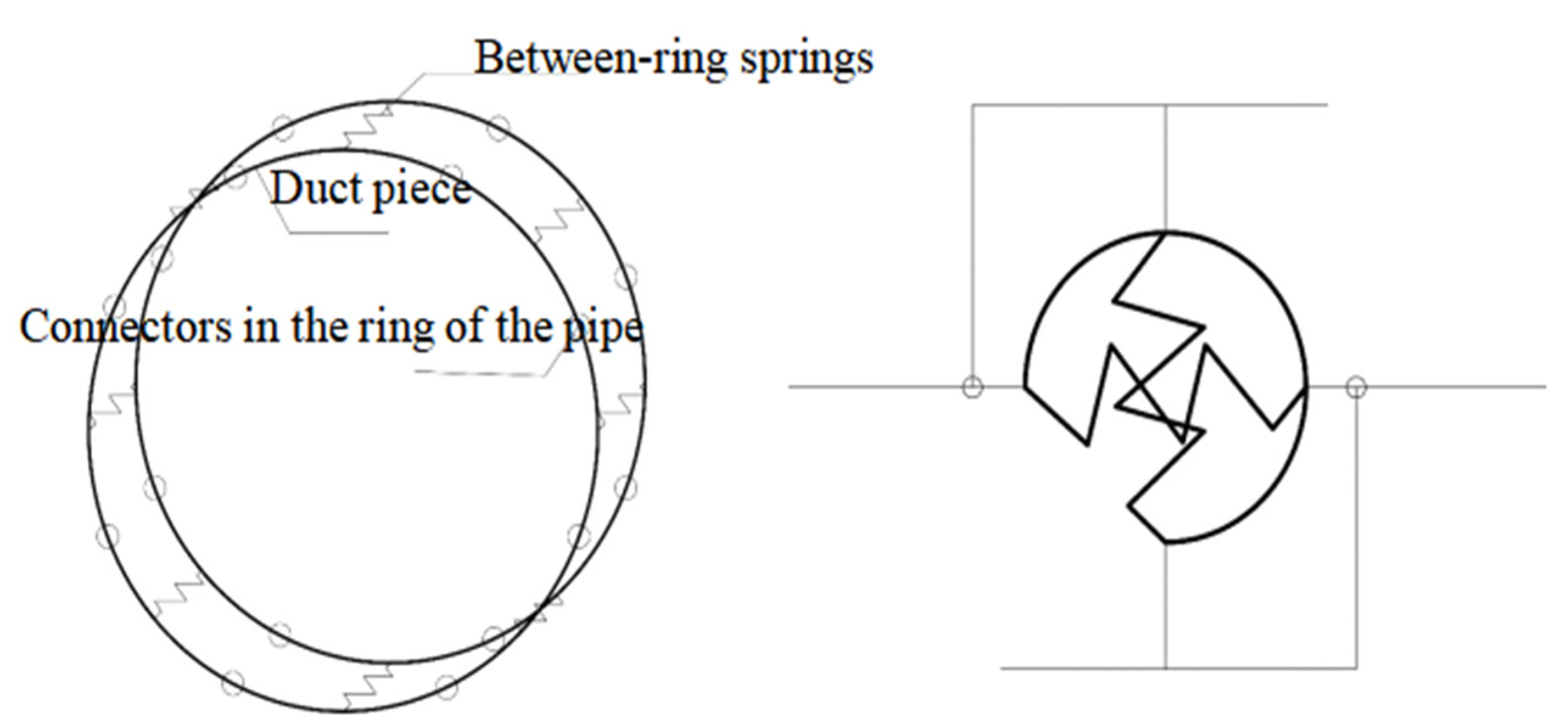






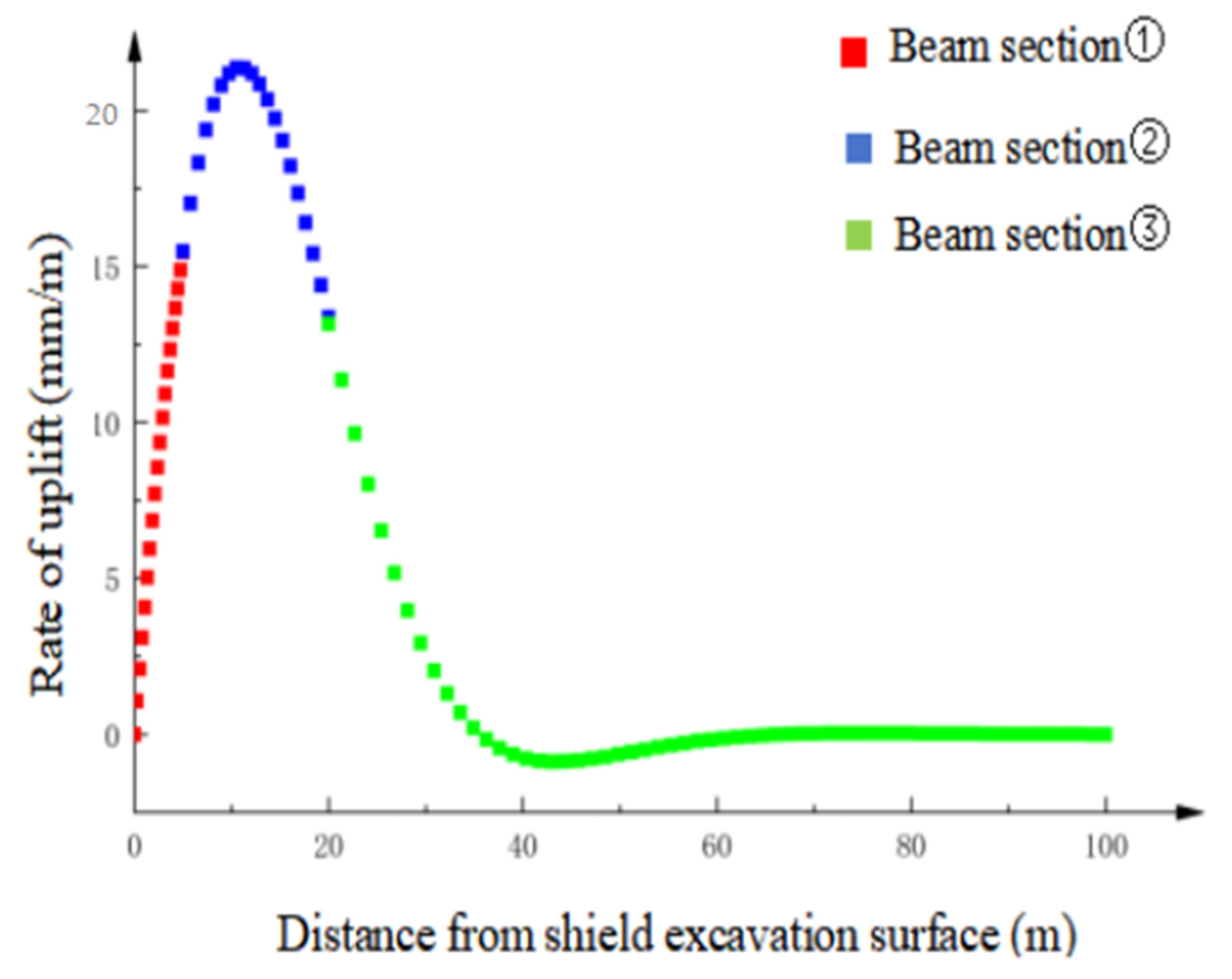


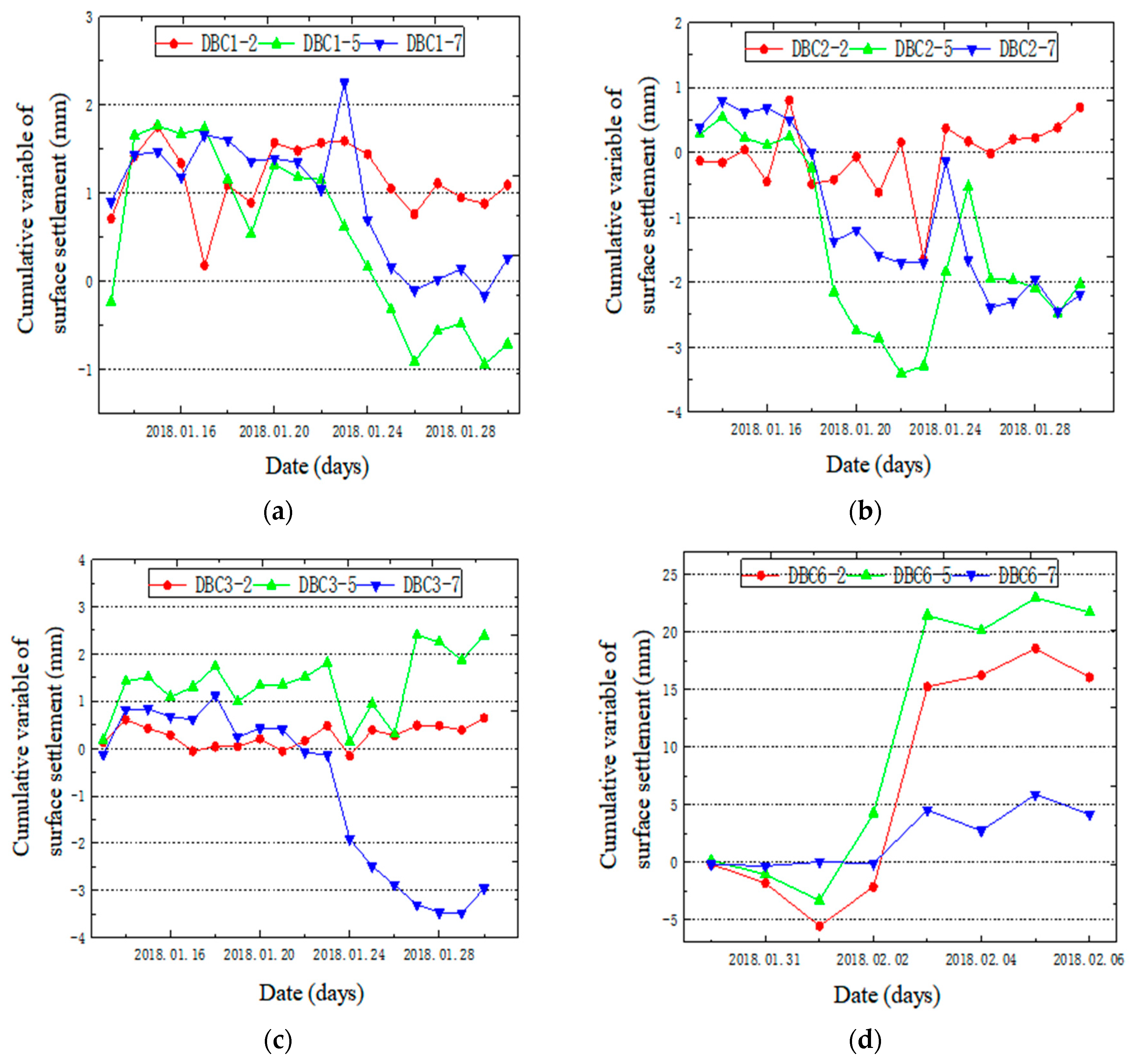
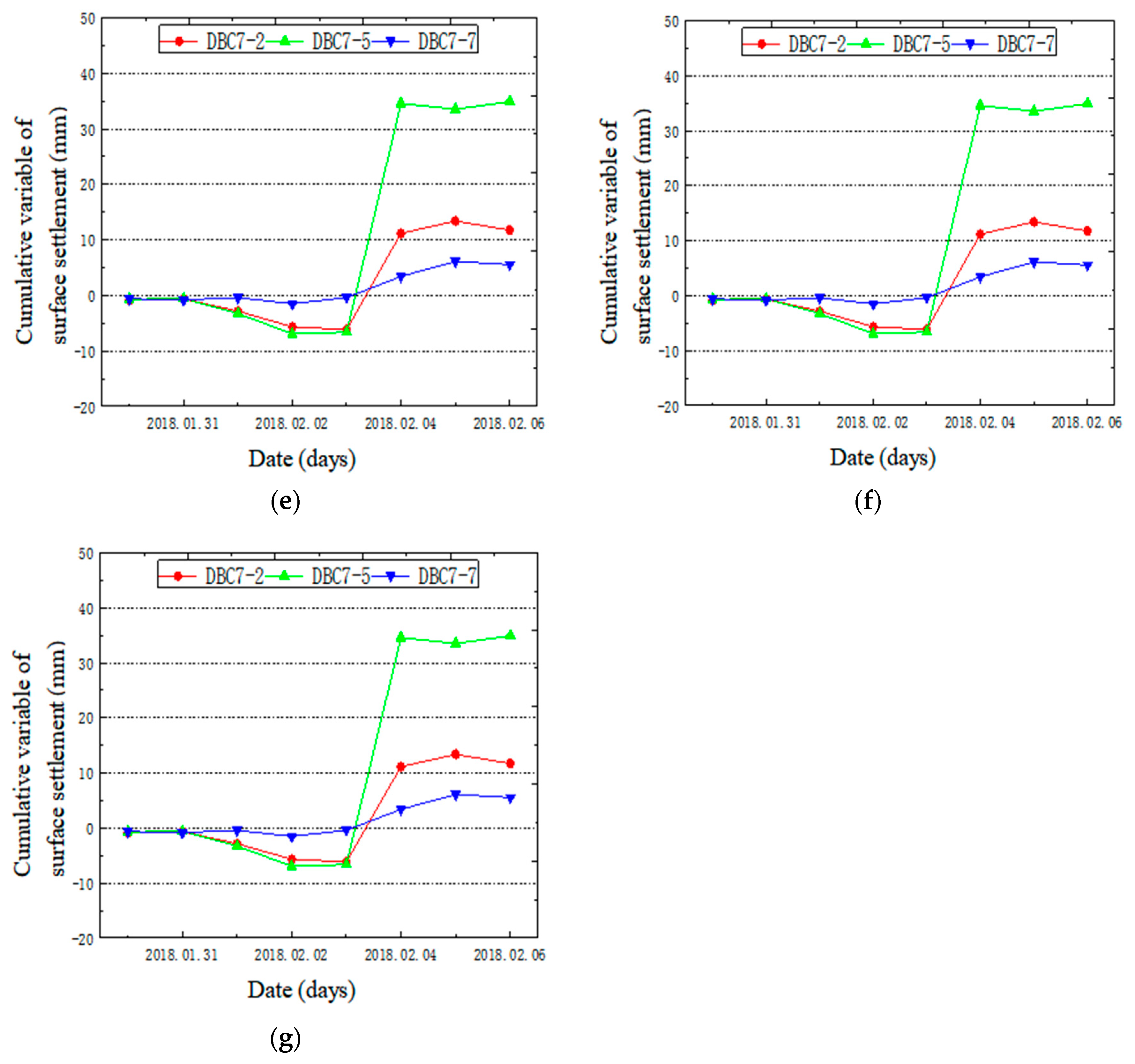
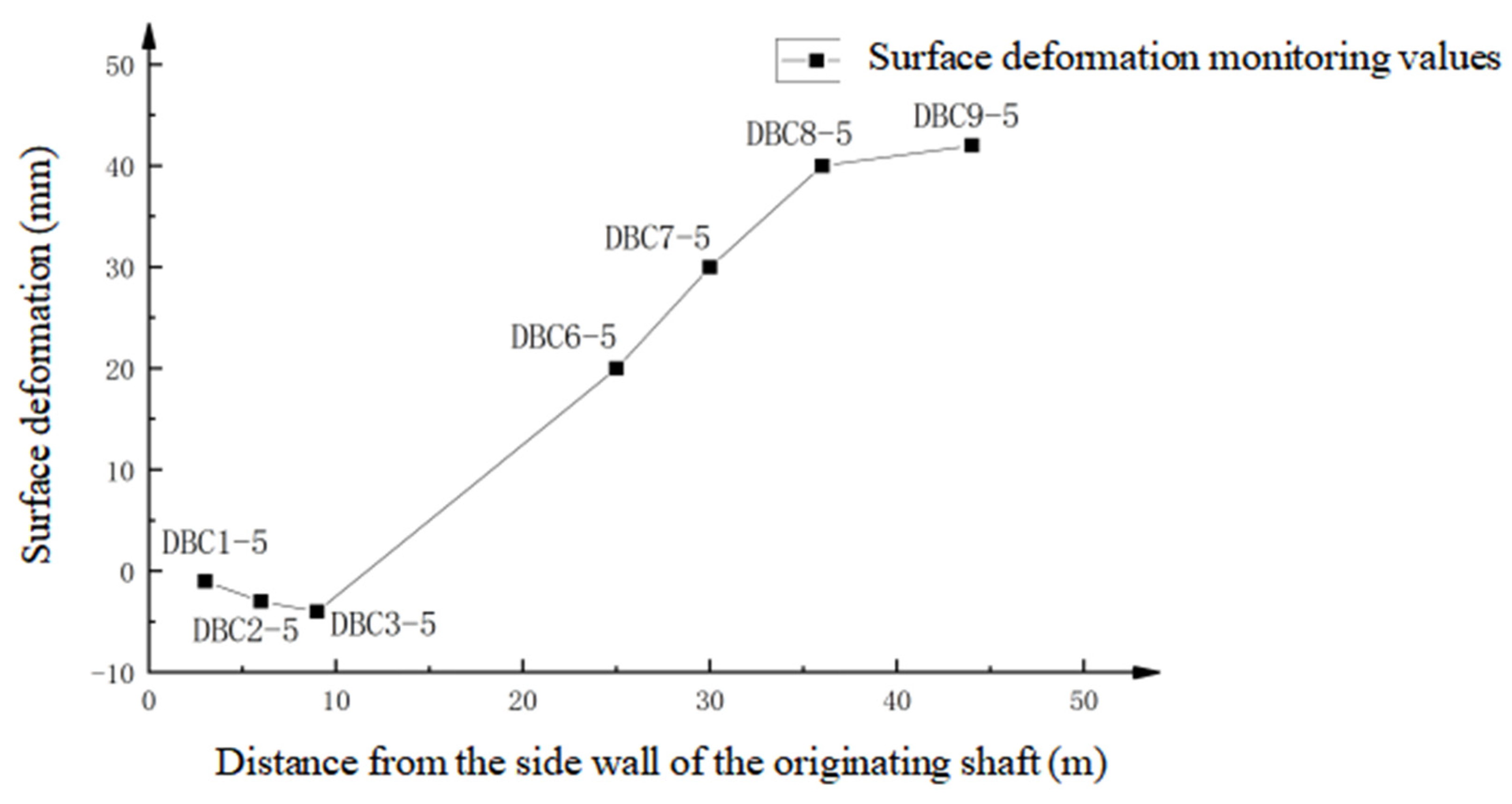

Disclaimer/Publisher’s Note: The statements, opinions and data contained in all publications are solely those of the individual author(s) and contributor(s) and not of MDPI and/or the editor(s). MDPI and/or the editor(s) disclaim responsibility for any injury to people or property resulting from any ideas, methods, instructions or products referred to in the content. |
© 2024 by the authors. Licensee MDPI, Basel, Switzerland. This article is an open access article distributed under the terms and conditions of the Creative Commons Attribution (CC BY) license (https://creativecommons.org/licenses/by/4.0/).
Share and Cite
Wu, J.; Chen, J. Experimental Research on the Floating Amount of Shield Tunnel Based on the Innovative Cumulative Floating Amount Calculation Method. Buildings 2024, 14, 1228. https://doi.org/10.3390/buildings14051228
Wu J, Chen J. Experimental Research on the Floating Amount of Shield Tunnel Based on the Innovative Cumulative Floating Amount Calculation Method. Buildings. 2024; 14(5):1228. https://doi.org/10.3390/buildings14051228
Chicago/Turabian StyleWu, Jingrong, and Jing Chen. 2024. "Experimental Research on the Floating Amount of Shield Tunnel Based on the Innovative Cumulative Floating Amount Calculation Method" Buildings 14, no. 5: 1228. https://doi.org/10.3390/buildings14051228



